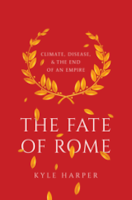
Princeton (2017) h/b 417pp. £27.95 (ISBN 9780691166834)
It is impossible not to account for some of the success of Rome by good luck. The short-lived but climatically near-perfect moment of the Holocene epoch, referred to as the ‘Roman Climate Optimum’ (roughly 200 BC to AD 150), provided warm, damp weather that enabled a particularly virtuous cycle. Harvests are richer; more and higher land can be handed over to agriculture; a greater population can be sustained; more (human) resource is available for the further development of what sustains it.
But, as we know, climate changes. Not, of course, at the flick of a switch, but usually through a period of unpredictable and disruptive weather. Around AD 150 the ‘Late Roman Transitional’ period began, running through to 450, during which drought, cooling, aridification and interruptions in the inundations of the Nile all occured. Clearly, Christians/pagans (take your pick) were to blame. The actual causes were many—weather systems in the Atlantic, El Nino, monsoon effect, solar activity. The knock-ons were, of course, social, economic, political, religious—the list is pretty open-ended. Then came the onset of the ‘Late Antique Little Ice’ Age: 356 was the ‘Year without Summer’, when solar activity receded and volcanic activity reached a high; temperatures fell and flooding increased; living conditions changed, and nations felt forced to migrate. Luck had changed.
If only that were all. But the successful empire the Romans created strengthened another natural development. There was always disease, and despite the miracle of Roman civil engineering, faecal-oral transmission of disease was ubiquitous, Rome was a malarial area with seven healthy hilltops, and high infant mortality was an expectation. But the Empire was open to more than home-grown pathogens: ‘To understand the role of disease in the Roman world, we must try to think of the empire as an environment for its invisible residents. The dense urban habitats, the unflinching transformation of landscapes, the strong networks of connectivity within—and especially beyond—the empire, all contributed to a unique microbial ecology’. Right now we think the pathogen that caused the Antonine Plague of 165 was smallpox, that the Plague of Cyprian (249-262) could be ’flu or Ebola-related. The Justinianic Plague, 541, with outbreaks to 749, was certainly bubonic plague—the genome has been read. One estimate is that the latter took out half the Empire. Its longevity was down to the fact that the pathogen could retreat into its familiar rodent populations, and the pop out again.
So this is the story H. interweaves into his historical narrative, along with the literary and epigraphic evidence we would reasonably expect. It is the first time that such diverse evidence, from so wide a range of scientific disciplines, has been brought together to tell a story complex enough to have spawned over two hundred theories, and there’s much more evidence still to come.
Harper ends, though, with something pretty positive—about the resilience of the people against increasingly irresistible odds, and he leaves us with Gibbon’s marvelling not at the fall of the Empire, but that it ‘had subsisted so long’.
This beautifully written book is ground-breaking stuff, both for its method and content, and one of the most important of the year.
Adrian Spooner
